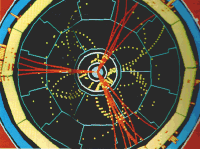
Science |
Is this the cleverest man in the world?
 |
He won a Nobel prize, but since then his interests have widened. Now he's
on a quest for a real Theory of Everything
Murray Gell-Mann has been described as The Man With Five Brains and it's
not hard to understand why. He is an emeritus professor of physics, an
international advisor on the environment, an authority on the origin of
languages, arms control and foreign relations oh yes, and he has a Nobel
prize for solving a key mystery of the universe.
Despite his sprite-like appearance, he also has a reputation for dealing
with fools the way a killer whale deals with penguins. But then, it cannot
be easy being The Man With Five Brains in a world with more than its fair
share of Men With Half A Brain.
Pausing in London to talk to Focus about his new book on the science of (almost)
everything, he pulls out a slip of paper he has been given in a major London
bookstore. It shows that his book The Quark and the Jaguar has been
classified under "Fiction - General", and the author as "Mann, M. Gell"
.A review in the Sunday Times spells his name Gell-Man."
For someone who spends his time thinking about subjects most people cannot
even spell, it must all be a bit wearing. But he has had time to get used
to it: the fact is Gell-Mann has been a prodigy almost all his 65 years.
Born in New York at the start of the Great Depression, Gell- Mann's intellectual
childhood was dominated by his father, an , Austrian immigrant who struggled
to keep his family out of Skid Row. It was from him that Gell-Mann gained
a fascination for science and mathematics.
Gell-Mann junior decided to teach himself calculus, the mathematical technique
for calculating the effects of varying values. There were problems, however:
I had a textbook by Sylvanus P Thompson, but I didn't like the way he dodged
some important issues, like the concept of a limit," he recalls. But then,
Thompson was merely a Fellow of the Royal Society , and Gell-Mann was all
of seven years old.
Still just 15, Gell-Mann went to Yale. Curiously, his original plan had been
to study linguistics or archaeology: despite his original enthusiasm, he
found school physics, with its dreary lists of laws and seemingly unconnected
disciplines, insufferably dull. His father, fearful for his son's employment
prospects, wanted him to study engineering. As a compromise,Gell-Mann took
physics. Brilliant teaching opened Gell-Mann's eyes to the esoteric delights
of theoretical physics, and he went on to secure a PhD from the Massachusetts
Institute of Technology in
quantum theory,
the physics of the subatomic world.
Still in his early 20s, Gell-Mann solved a key mystery about the quantum
realm: why did some unstable particles then being found in particle accelerators
disintegrate much more slowly than scientists expected? Gell-Mann found the
answer by invoking the idea that particles possessed "strangeness" , a
fundamental new property of matter to go with more familiar ones, like electric
charge, and mass.
This breakthrough led to the idea for which he is most famous. During the
1950s and early 1960s, scientists were discovering more and more
"fundamental" particles, with bizarre names like the
Sigma and Xi. As the situation became more perplexing, the suspicion arose
that there must be an underlying order in the subatomic menagerie.
In 1962 Gell-Mann had glimmerings of that order. The newly found particles
seemed to fall into neat patterns, dictated by how much strangeness and electric
charge they had. Intriguingly , one of the patterns appeared to have a particle
missing. Surely , Gell-Mann reasoned, Nature would not spoil these beautiful
patterns by leaving out a particle. He therefore calculated what the missing
particle's properties should be, including its mass. Sure enough, in 1964
experimentalists using particle accelerators found the particle - the Omega-minus
- with nearly exactly the mass predicted.
Only obeying order
|
 |
It was a major triumph for Gell-Mann, yet it raised an obvious question:
why did those patterns exist? Again, he supplied the answer: inside the Sigma
and similar particles were even more fundamental particles, different
combinations of which give the particles their unique properties.
Gell-Mann called these sub-subatomic particles
"quarks"
a nonsense word rhyming with "walk" Later he found the same word in James
Joyce's Finnegans Wake thus guaranteeing him a lifetime of irritation,
as even textbooks persistently claim that he lifted the word from "Finnegan's
Wake", and that it rhymes with "park".
Even more annoying has been the claim that he did not even believe in quarks.
"I always believed they were real - I just said that they had such strange
properties that they were better stuck away where they can't be seen," he
insists. "But I didn't know that one could find them inside particles."
There, at least, the experimental physicists had a surprise for him: by blasting
high-speed electrons into hydrogen atoms, they have succeeded in detecting
quarks lurking inside their host particles like tiny nuggets. In 1969 Gell-Mann's
work on subatomic particles was rewarded with a Nobel Prize in physics -
one of only six given unshared to a scientist in the last 25 years. "I did
feel a little embarrassed that I should have been selected alone," he admits,
adding puckishly. "The award did not mention quarks - I could still get one
for that!"
Since winning the award he has continued to make major contributions to the
understanding of subatomic particles. In the 1970s he played a key role in
creating the theory that explains how quarks and the so-called "colour force"
between them prevent the hearts of atoms flying apart. "Colour" like
"strangeness", is a whimsical term given by scientists to the abstract
mathematical and physical properties of particles.
More recently , he has become a vocal supporter of a controversial theory
that some physicists think may account for all the forces and particles of
the universe known as
superstring
theory, it is based on the idea that all of physics is ultimately the
result of vibrations of "super- symmetric strings": bizarre, multidimensional
entities far smaller than the smallest particle.
Gell-Mann suspects that applying this theory to such mysteries as how the
universe was born will produce major breakthroughs."To those thinking of
a career in physics I would recommend that they try to work on joining
super-string theory and cosmology."
He does not, however, call superstring theory a
"Theory of
Everything", as some physicists have dubbed it. "That is a misleading
characterisation, unless "everything" is taken to mean only the description
of the elementary particles and their interactions." What the ingredients
of a true Theory of Everything might be is the subject of his new book.
Covering an astonishing range of subjects, The Quark
and the Jaguar gives an insight into what the other four brains of Gell-
Mann have been up to. Essentially , it describes how
phenomena around us - a child learning to speak, the behaviour of an
economic
system - emerge from more simple elements. According to Gell-Mann, our
world is made up of simple elements like quarks and "complex adaptive systems",
which he describes using the metaphor of that sophisticated, mysterious beast,
the jaguar.
Understanding ,
"emergent
complexity" has become one of his great passions, leading him to become
a founder of the Santa Fe Institute in California, where like-minded scientists
ponder the emergence of everything from language to life itself.
Maybe such questions are too big even for Gell-Mann. Some scientists think
all the talk of emergent behaviour and complexity theory is just jargon for
quarter-baked ideas with little chance of becoming even half- baked. But
this doesn't faze Gell-Mann. He seems simply to enjoy seeing where his mental
powers will take him next.
"I've just got back from recording birdsong," he says. Where - near his home
in Santa Fe? Of course not: "In Bhutan." And then suddenly we have it - the
Man With Five Brains reveals his secret. "I don't know what spare time is."
Making the complex simple:Gell-Mann on.... |
|
Mysterious Phenomena "One of my favourite examples of mysterious phenomena has to do , with fish and frogs falling from the sky. All , the meteorologists that I have consulted assure me that their science does not provide any conclusive objection to the possibility. Moreover, if fish or at least their spawn do come down alive, that could make a serious difference to zoogeography, the study of the distribution of animal species. If fish really do tumble from the heavens, the process doesn't do any damage to the accepted laws of science; in fact it probably helps. The degree of scepticism that is applied should be appropriate to the challenge that the alleged phenomenon presents to the accepted laws." |
|
A fishy phenomenon
|
|
The 'soft' sciences ' "I personally have always been astonished by the tendency of so many academic psychologists, economists and even anthropologists to treat human beings as entirely rational or nearly so. Assuming that humans are rational often makes it easier to construct a theory of how they act, but such a theory is often not very realistic." |
|
Life and the universe "There is no indication that there is anything terribly special about the formation of a planetary system like the solar system or about its including a planet like the Earth. Nor is there any evidence that the chemical reactions that initiated life on this planet were in any way improbable." |